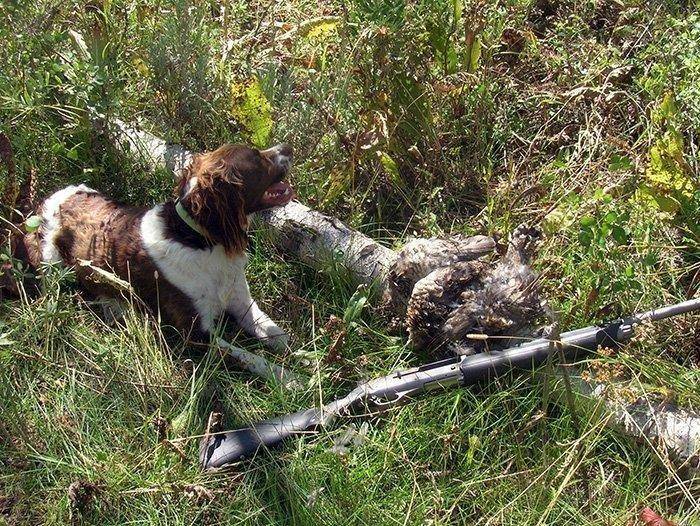DWR Press Release
It looks like mild conditions helped adult forest grouse in Utah last winter. And the same dry, mild conditions can help you as a hunter; finding areas that are greener than surrounding areas should put you on birds this year.
Jason Robinson, upland game coordinator for the Division of Wildlife Resources, said reports from DWR field biologists indicate the number of forest grouse is average — or, in the case of dusky grouse, slightly above average — going into this fall’s hunt.
Robinson said mild temperatures and a lack of snow allowed plenty of adult birds to survive the winter and enter the spring breeding season in good condition. Once hatched, though, their chicks faced tough conditions. “Dry conditions meant less water,” Robinson said, “and less water meant fewer forbs and insects for the chicks to eat. Chick survival was likely down this year.”
Despite fewer young birds, plenty of adult grouse are available to hunt. “I think this fall’s hunt will be a good one,” said Robinson, an avid forest grouse hunter. “Finding areas that are greener than surrounding areas, and then focusing your efforts in those areas, will be the key to taking birds this year.”
Utah’s forest grouse hunt starts Sept. 1. Ruffed grouse are found on mountain ranges extending from the Idaho border south to Fish Lake and the north and south slopes of the Uinta Mountains extending east to the Colorado border. Dusky grouse are more widespread: any pine, fir or spruce forest above 7,000 feet in elevation likely has dusky grouse in it.
Maps that show where dusky and ruffed grouse live in Utah — and more information about the birds themselves — is available on pages 33 and 44 of the 2018–2019 Utah Upland Game and Turkey Guidebook. You can get the free guidebook at wildlife.utah.gov/guidebooks.
Once you’ve put yourself in the right areas in the state, Robinson provides tips to help you find birds:
Ruffed grouse
Tip 1 — Look for aspen trees and thick cover
To find ruffed grouse, scan the forest, looking for stands of white-trunked aspen trees. Once you’ve spotted a stand, head for it. If ruffed grouse are in the area, you’ll find them in the aspen tree stand or in pine, maple or oak tree forest that’s close to the aspen trees.
All aspen stands aren’t created equal, though. The thicker the cover in the stand, the more likely it harbors ruffed grouse. “Ruffed grouse live in cover that’s thicker than many hunters expect or want to hunt in,” he said. “They love thick cover.”
Dusky grouse
Tip 1 — Move higher as the season progresses
Dusky grouse do something most wildlife species don’t: as conditions get harsher, dusky grouse move higher in elevation.
In early September, you’ll usually find duskies in aspen, pine, fir or spruce tree stands that have a thick understory. An understory that includes snowberries, serviceberries and other types of berries is especially attractive.
By October, the birds have climbed to ridgelines dotted with pine, fir or spruce trees. Then, starting about Nov. 1 — and continuing through the end of the season — dusky grouse will be 9,000 to 10,000 feet in elevation.
“During the last part of the season,” Robinson said, “dusky grouse feed entirely on the needles of pine, fir or spruce trees. And they zero in on areas that have certain types of trees. Douglas fir trees are, by far, their favorite tree at the end of the hunting season.”
Once you’ve put yourself in the right habitat, it’s time to hunt. The tips Robinson provides apply to both ruffed and dusky grouse hunting:
Hunting with a dog
Tip 1 — Put your dog in the right habitat
Your dog can’t find birds if there aren’t birds to be found. Identify the right habitat before putting your dog to work. And, remember, the greener the vegetation this year, the better. “Once you’ve identified a good spot,” Robinson said, “trust your dog. Let it do its thing.”
Tip 2 — Hunt early in the day
Hunt early in the day, when the temperature is cooler and the humidity is higher. These conditions will make it easier for your dog to pick up the birds’ scent.
Tip 3 — Give your dog plenty of water
Keeping your dog hydrated will also help it pick up scent easier.
Hunting without a dog
Tip 1 — Put yourself in the right habitat
As mentioned above, put yourself in an area that likely has birds in it. Remember, the greener the vegetation this year, the better.
Tip 2 — Walker slower
Walking slowly, stopping, walking and then stopping again is often the key to putting grouse in the air. “Walking slowly, and stopping often, causes grouse to think you’ve spotted them,” he said. “That’s often what it takes to get them to flush.”
Tip 3 — Walk trails during the early morning
During the morning, grouse often head to trails and other open spots to pick up the grit they need to grind their food. Walking trails in the early morning can often put you on top of grouse.
Tip 4— Be alert
While hunting grouse, always be ready to shoulder your gun and shoot. Grouse flush quickly and fly away fast.

